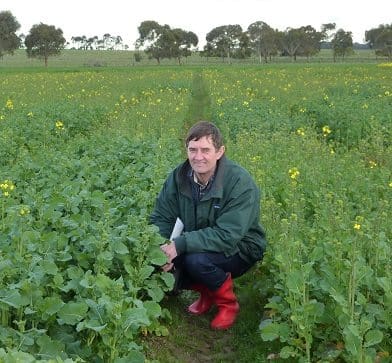GRAIN growers in the southern cropping region’s high rainfall zone (HRZ) could be limiting their yields and profits by not applying enough fertiliser to their crops.

Dr Malcolm McCaskill says commercial wheat and canola yields are well below their water-limited potential in the high rainfall zone. (Photo: Fiona Robertson)
A Grains Research and Development Corporation (GRDC) research investment has found that under-fertilising in the high rainfall zone (HRZ) appears to be a major cause of yield gaps – the difference between the actual yield achieved by a grower and the water-limited yield potential.
Research led by Agriculture Victoria soil scientist, Dr Malcolm McCaskill, has established that by providing sufficient nutrients, wheat and canola yields could be equal to or even exceed the water-limited potential, except in cases of severe waterlogging or drought.
“Commercial wheat and canola yields are well below their water-limited potential in the HRZ. The potential is defined as the maximum possible yield able to be grown with the optimal sowing date, current varieties and non-limiting nutrients, and with minimal detrimental effect from pests, diseases and weeds,” Dr McCaskill said.
Under-fertilising in the HRZ could be linked to the use of soil test interpretation guidelines developed for low and medium rainfall areas.
Dr McCaskill said these guidelines might not be appropriate for the HRZ, given its higher yield potential.
To assist HRZ growers in achieving higher yields, Dr McCaskill and his research team have produced three Excel-based decision-support tools to determine the economic optimum application rate of nitrogen (N), phosphorus (P), potassium (K) and sulphur (S) under a range of conditions.
“These tools could help growers estimate the most economic rates of fertiliser,” he said.
“The tools support decisions for wheat and canola crops during the growing season. They allow for first-rate decisions firstly at sowing, and then for in-crop application of N at early stem elongation when the yield outlook is clearer.”
Fertility response relationships are based on extensive nutrient response trials across the southern region.
The economic optimum fertiliser application rate is also dependent on input prices, product price and seasonal outlook, and the three spreadsheets calculate the optimum under a wide range of conditions.
Some growers are reluctant to use the economic optimum fertiliser rate, because seasonal conditions and variable prices makes returns far from certain. This conservative approach limits the ‘downside’ but also restricts the potential to exploit favourable conditions.
The three tools address three different questions:
- The first is an awareness tool showing likely response to in-crop N, based on the initial P, K and S fertility. It uses input data to estimate how profitable it is to apply N to wheat or canola with different P, K & S levels, seasonal outcomes and market prices.
- The second is a planning tool to assist with pre-sowing applications of N, P, K and S and in-crop decisions based on climate forecasts. The tool offers the opportunity to “top-up” in-crop N application as the season develops.
- The third is an evaluation tool to check whether the crop was under fertilised or over fertilised, post-crop. Growers can look back at the N, P, K and S applications for a crop to check if they used the most profitable combination of nutrients.
The spreadsheets are populated with yield and nutrient response data from a biophysical model, but allow modification to suit individual circumstances.
Source: GRDC
The tools can be downloaded free of charge via the eXtensionAUS website at goo.gl/ji99PB.
Dr McCaskill is seeking feedback from growers and advisers on how the tools perform and whether they assisted in fertiliser decision making. Feedback can be emailed to [email protected], or phone (03) 5573 0957.
Dr McCaskill’s GRDC Grains Research Update paper, “filling the yield gap – optimising yield and economic potential of high input cropping systems in the HRZ”, can be found at goo.gl/qBsBky

HAVE YOUR SAY